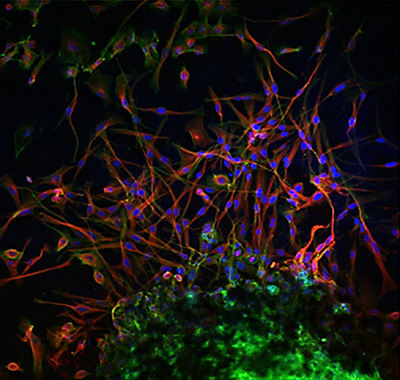
CornealCellVision: Derivation of corneal keratocytes from canine induced pluripotent stem cells to develop disease models and novel treatments for corneal disease
This project will generate corneal stromal tissue in the laboratory to pave the way to the development of an artificial cornea for future disease modelling and clinical transplantation into injured and diseased dog eyes to restore vision.

Challenge
The cornea, as transparent window to the world are critical for vision. Corneal diseases are one of the most common debilitating source of visual loss that may lead to permanent blindness in humans as well as in animals. The CornealCellVision team is aiming to understand the biology and therapeutic potential of stem cells (and their differentiated corneal cells) to develop novel cell-based therapies and anti-scarring strategies for patients with blinding corneal disease. Furthermore to develop disease models to understand the pathophysiology of corneal disease and develop new treatment options (Figure 1). In this specific project we aim to establish clinically safe pluripotent stem cells and to develop a corneal tissue scaffold, so that veterinary medicine can take advantage of the significant advances being made with cell therapies in humans. The CornealCellVision project, led by Dr. Christiane Kafarnik, is a collaborative project between members of the RVC stem cell group and Professor Julie Daniels (Institute of Ophthalmology, UCL).
Solution
Fat cells will be collected from dogs as part of the RVC Educational Memorial Programme (EMP). We, and others research group have previously derived pluripotent stem cells from these cells in dogs (ciPSC). Our recent research focused on the use of safer reprogramming systems that can generate “footprint free” canine iPSCs. This study builds upon our previous work where we have identified the conditions required to enable stem cells from ciPSC to differentiate into cells similar to native corneal cells. However, we know from studies in people that it is essential to mimic a more natural environment (3D scaffold) for these cells during the differentiation process. This will be addressed in this project. We have recently demonstrated that the dog cornea also contains corneal stromal (stem) cells. In this project these cells will be placed in the 3D culture system to be able to measure the degree of similarity of corneal cells derived from ciPSC to the original tissue. The stem cell group as part of the Centre for Vaccinology and Regenerative Medicine is located at the Hawkshead Campus with ideal laboratory settings (e.g. flow cytometry core facility) and state-of-the-art GMP facility.
Impact
This project will continue the successful collaboration between the investigators and brings together their expertise in canine stem cells and human cell therapy. The derivation of corneal stromal cells from iPSCs will provide future modelling disease pathogenesis (such as corneal dystrophies) and will also complement genetic studies. The study findings will help to generate corneal stromal cells from iPSCs to provide a source of cells for clinical translation in the long-term future. Corneal injury and disease leading to severe scarring affecting a large number of dogs. The long-term outcomes of the project are predicted to have a significant welfare impact in the future. The findings so far have been published in several papers. In addition, the team have presented at various international meetings.

Partners
We thank the Petplan Charitable Trust (S21-967-1006) funding this research.
Publications
| Title | Publication | Year |
| Differentiation of canine adipose derived stromal cells along the keratocyte lineage in vitro | ARVO proceedings | 2022 |
| Stem cells and development | 2020 | |
| Cytometry A | 2018 | |
| Deriving an in vitro source of canine corneal stromal cells for future studies of corneal disease and therapeutic applications: a translation from human research towards veterinary science | Gordon Research meeting proceedings | 2018 |
| Reproduction in domestic animals | 2015 |
